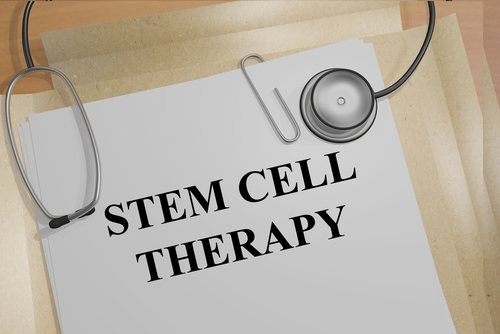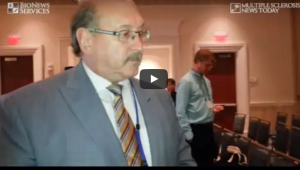Aggressive Stem Cell Therapy Stops MS Relapses, According to Long-term Clinical Trial
Written by |

Stem cell treatment has been proven to both halt MS clinical relapses and the development of new brain lesions over a prolonged period, according to the results of a new study.
The results, achieved in 23 out of 24 patients in a Phase 2 clinical trial, were published in The Lancet in an article titled “Immunoablation and autologous haemopoietic stem-cell transplantation for aggressive multiple sclerosis: a multicentre single-group Phase 2 trial.”
Importantly, the success was reached without the need for ongoing medication.
It is the first time that results of this form of autologous haematopoietic stem cell transplantation (aHSCT) have been trialed — using chemotherapy to completely destroy a patient’s immune system and then transplant previously harvested stem cells to reset or reboot the immune system to stop it harming the body. It is the method used in several leading clinics, including those in Russia and Mexico.
Some other centers, however, only go as far as suppressing, not destroying, the immune system. According to a recent press release, the suppression method is not as reliable, with many patients finding that improvements don’t last.
Dr. Harold L. Atkins and Dr. Mark S. Freedman (who recently spoke about stem cell therapy in an interview with Multiple Sclerosis News Today) from The Ottawa Hospital and the University of Ottawa in Canada led the trials funded by the Multiple Sclerosis Scientific Research Foundation. They tested whether complete destruction, rather than suppression, of the immune system during aHSCT would reduce the relapse rate in patients and increase long-term disease remission.
They enrolled 24 patients ages 18 to 50 from three Canadian hospitals who had all previously undergone standard immunosuppressive therapy, which did not control the MS. All the patients had a poor prognosis, with their disability ranging from moderate to requiring a walking aid to walk 100 meters, according to their Expanded Disability Status Scale (EDSS) scores.
The researchers used a method of aHSCT similar to the one currently used. But instead of suppressing the immune system before transplantation, they destroyed it completely, using a chemotherapy regimen of busulfan, cyclophosphamide, and rabbit anti-thymocyte globulin.
Atkins explains that this treatment is “similar to that used in other trials, except our protocol uses stronger chemotherapy and removes immune cells from the stem cell graft product. The chemotherapy we use is very effective at crossing the blood-brain barrier, and this could help eliminate the damaging immune cells from the central nervous system.”
The primary outcome of the study was multiple sclerosis activity-free survival at three years (as measured by relapses of MS symptoms, new brain lesions, and sustained progression of EDSS scores), which occurred in 69.6 percent of patients after transplantation.
Sustained improvement from stem cell therapy
Of the 24 patients, one (4 percent) died from hepatic necrosis and sepsis caused by the chemotherapy. Before the treatment, patients experienced 1.2 relapses per year, on average. After treatment, no relapses occurred during the follow-up period (between four and 13 years) in the surviving 23 patients.
These clinical outcomes were reflected by freedom from detectable new disease activity on MRI images taken after the treatment. The initial 24 MRI scans revealed 93 brain lesions, and after the treatment only one of the 327 scans showed a new lesion.
Furthermore, progressive brain deterioration typical of MS slowed to a rate associated with normal aging in nine patients with the longest follow-up, and eight (35 percent) of 23 patients had a sustained improvement in their EDSS score at 7.5 years after treatment.
At three years, six patients (37 percent) could return to work or school with reduced or no disability benefits. Eight (33 percent) of the 24 patients had a moderate toxic effect, and 14 patients (58 percent) had only a mild toxic effect related to transplantation.
Commenting after publication of the report, Freedman highlighted the need to interpret the results with caution. “The sample size of 24 patients is very small, and no control group was used for comparison with the treatment group. Larger clinical trials will be important to confirm these results,” he said.
“Since this is an aggressive treatment, the potential benefits should be weighed against the risks of serious complications associated with aHSCT,” Freedman added. “This treatment should only be offered in specialist centers experienced both in multiple sclerosis treatment and stem cell therapy, or as part of a clinical trial. Future research will be directed at reducing the risks of this treatment as well as understanding which patients would best benefit from the treatment.”
Dr. Jan Dörr, from the NeuroCure Clinical Research Center, Charité-Universitätsmedizin in Berlin, Germany, said: “These results are impressive and seem to outbalance any other available treatment for multiple sclerosis. This trial is the first to show complete suppression of any inflammatory disease activity in every patient for a long period. However, aHSCT has a poor safety profile, especially with regard to treatment-related mortality.
“So, will this study change our approach to treatment of multiple sclerosis? Probably not in the short term, mainly because the mortality rate will still be considered unacceptably high,” he added.
Dörr also said that over the longer term, in view of the increasing popularity of using early aggressive treatment, there may be support for considering aHSCT less as a rescue therapy and more as a general treatment option.
This can be done, he said, provided the different protocols are harmonized and optimized, the tolerability and safety profile is further improved, and prognostic markers become available. Such markers could identify patients at risk of poor prognosis in whom a potentially more hazardous treatment might be justified.
Note: Multiple Sclerosis News Today is strictly a news and information website about the disease. It does not provide medical advice, diagnosis, or treatment. This content is not intended to be a substitute for professional medical advice, diagnosis, or treatment. Always seek the advice of your physician or other qualified health provider with any questions you may have regarding a medical condition. Never disregard professional medical advice or delay in seeking it because of something you have read on this website. The opinions expressed in this blog article are not those of Multiple Sclerosis News Today and are only intended to spark discussion about issues pertaining to Multiple Sclerosis.






